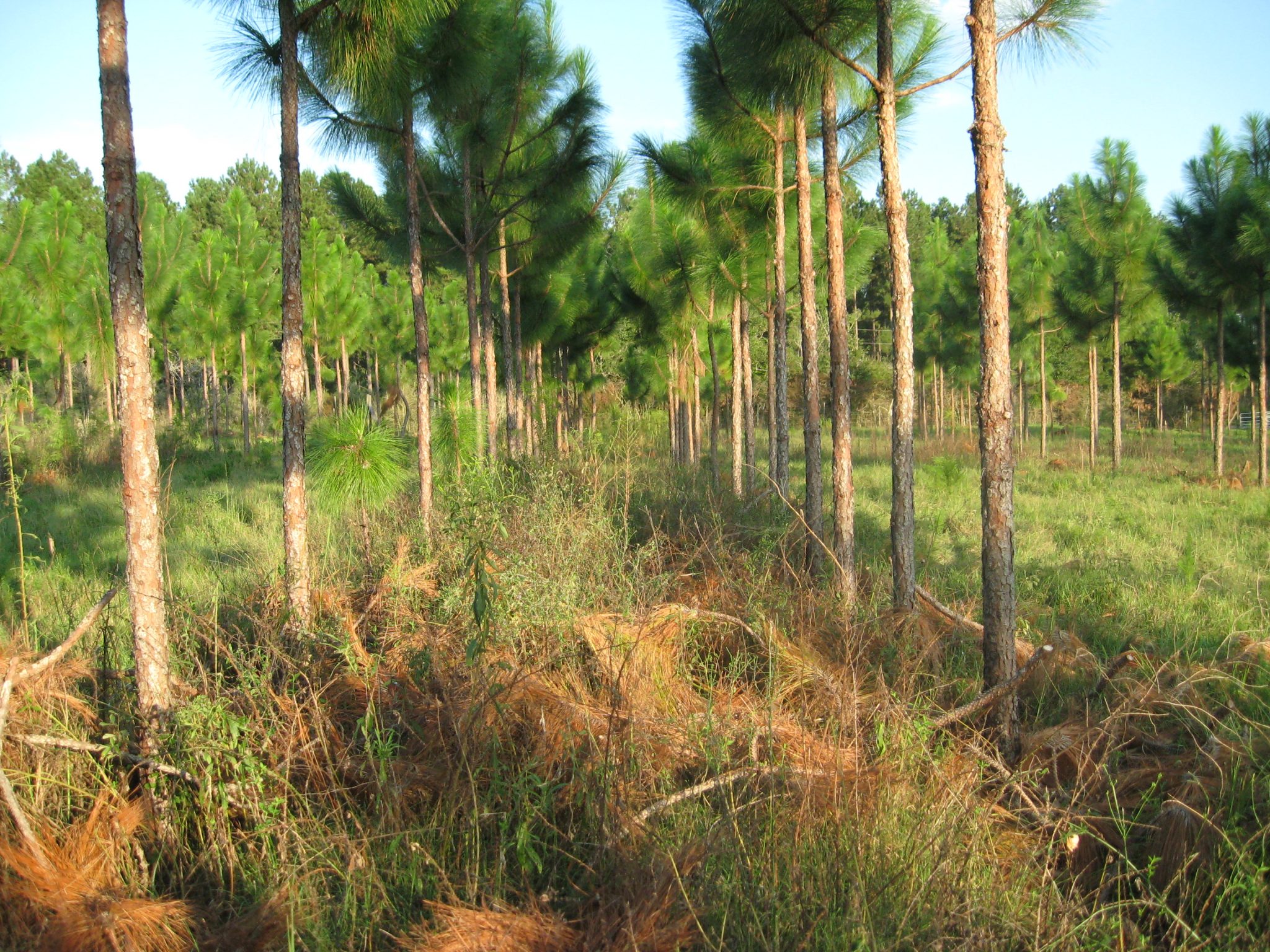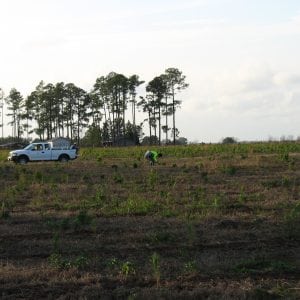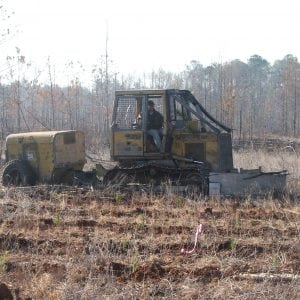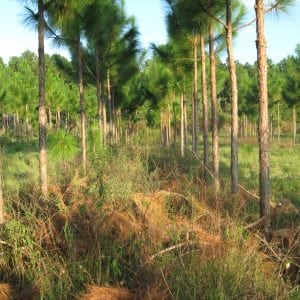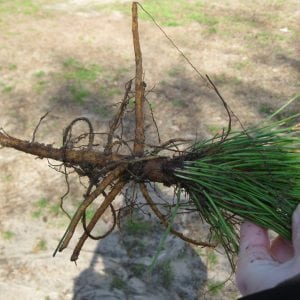Forestry

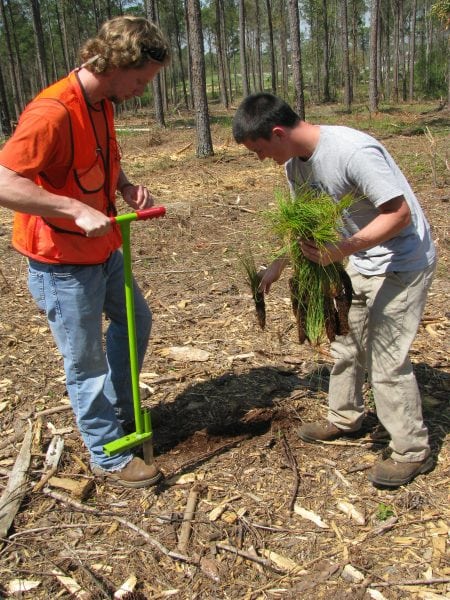
While landowners may enjoy planting small forest patches themselves, hand planting can be a big job that most will not want to do on their own.
(Photo credit: John Gilbert)
Before you begin replanting your land, a valid contract between you and the contractor or forest consultant is needed to protect all participants and outline objectives and requirements needed for a quality planting job. Although you should always consult an attorney before entering into any legal agreement, this information will help landowners draft successful reforestation contracts.
After you have harvested timber on your property, you may want to consider investing in your land by having it reforested, or replanted, with tree seedlings. In the South, most landowners replant their forestland with southern pine species such as loblolly, slash, longleaf, or shortleaf pine seedlings. However, depending on the stand location, there are times when hardwood species, such as red or white oaks, may be the best option. Seedlings can be bare-root or containerized and can be planted by hand or by using a specialized machine.
Regardless of the tree species chosen, using quality seedlings and proper tree-planting techniques can greatly improve seedling survival and future growth of trees. To protect your investment, you must ensure that planting is done properly. This can be a big task; therefore, many landowners do not want to tackle it on their own. Instead, many opt to hire an experienced forest consultant or contractor who can complete the job correctly and in a safe, professional, and efficient manner.
If you do choose to hire someone, you will need a contract between you and the contractor or forest consultant. A valid planting contract drafted before any replanting begins will protect all participants and outlines the objectives and requirements needed for a quality planting job. Although you should always consult an attorney prior to entering into any legal agreement, this publication will help landowners learn how to draft a successful reforestation contract.
What Is a Contract?
By definition, a contract is a legally enforceable agreement between two or more parties with mutual obligations. Contracts can be written, verbal, or implied, but for many reasons, a written contract is the best option for forest landowners. A reforestation contract should outline the following:
- Who will do the work
- Who will pay for the work done
- What the planting specifications will be (stock type, method of planting, etc.)
- Where the property is located and how many acres will be planted
- When the work will be completed
- How much will be paid for satisfactorily completed work
- What will be done if the work is not completed to specifications
Agreements based on a handshake can be misinterpreted or misunderstood; therefore, a written contract is necessary to provide proper documentation that can help protect you, the contractor, and your forestland.
What Should Be Included in a Tree-Planting Contract?
Many important aspects of the planting process need to be clearly understood by both the landowner and contractor. Tree-planting contracts should, at a minimum, include the intent of the landowner and contractor, the terms and conditions, rules, policy for possible dispute resolution, signatures, and any necessary supplemental information in an appendix.
- Contractors will provide labor, materials, equipment, and transportation needed to complete a planting job. (Photo credit: Becky Barlow)
- Contractor using a machine tree planter should take care not to allow fuel or oil leaks. (Photo credit: T.R. Clark)
Intent
This section of a planting contract primarily introduces all the responsible people who will be involved in the planting operation.
Who are the parties involved?
This section should include names, addresses, and contact information of landowner(s) and contractor(s). It should also include contact information for anyone you have authorized to act on your behalf. This person will serve as your agent for the duration of the contract. This is very important if you do not live close to your property or will not be available during the time of planting.
What does the owner need?
This section outlines what the landowner would like the contractor to do. In other words, it states what will be planted. The location of the property is also sometimes designated, referencing Exhibit A (Table 1), which includes a map of the property. See the section of this document on exhibits for more information.
Table 1. Contract Exhibits Provide Supplemental Information
| Contract Exhibits |
|---|
| Exhibit A – A map of the property |
| The area to be planted is highlighted, usually with cross hatching, or is outlined in color to illustrate where the work is to occur. This map should be to scale, have a north arrow, and contain as much detail as possible. Roads, streams, legal descriptions, and notes about the tract should also be included on the map. Number of acres to be planted should be designated and be as accurate as possible. Acres can best be determined using a handheld GPS unit. |
| Exhibit B – Payment rate and work specifications |
| This section may include but is not limited to information on the following: • Payment rate, usually per acre • Number of trees to be planted per acre and spacing • Tree quality specifications (no damaged, culled, or frozen trees) • How the seedlings will be planted (dibble bar, hoedad, or machine) • Acceptable planting practices (such as no root pruning or stripping) • Quality evaluations and allowable error |
| Exhibit C – Tree seedling specifications |
| Because quality seedlings can improve survival, the contractor should select only the best seedlings to plant. This exhibit details characteristics of seedlings that are acceptable to plant. |
| Exhibit D – Certificate of insurance |
| As mentioned earlier, a contractor must have insurance before beginning any planting job, and as a landowner, you have a right to obtain proof of insurance. The certificate of insurance is attached here along with any additional insured documentation that states that both the owner and agent are covered under the policy. |
What will the contractor provide?
This section outlines what work the contractor will do. It also specifies the work he or she is qualified to do. For example, it may state that the contractor provides forestry-related services such as planting. This section also affirms that the contractor will complete the work outlined in the contract.
Terms and Conditions
This portion of the contract could be considered as the heart of the contract describing when and how you expect the planting operation to be handled and what insurance and verification you require.
How long is this contract effective?
The term of the contract establishes specific dates when work will start and when it will be completed. You may also wish to outline criteria for extending the contract time frame in case there are unexpected work delays caused by inclement weather or seedling availability. A termination clause may also be included here.
- Planted longleaf pine. (Photo credit: John Gilbert)
- Seedlings may be container grown or bareroot like the longleaf pine seedling shown here. (Photo credit: Becky Barlow)
What will the contractor supply?
While the landowner usually supplies the seedlings and ensures that they are stored properly before planting, the contractor will supply all other labor, materials, equipment, and transportation needed to complete a planting job. This includes things such as planting tools and trailers to transport seedlings to the site. The contractor should also agree to comply with all state and federal employment laws, including laws that apply to immigration and migrant labor.
Is the contractor responsible for disposal of trash?
Contractors should not leave litter of any kind on your property and are responsible for its proper disposal. This includes food wrappers and planting bags or boxes. Similarly, if using a machine tree planter, the contractor should take care not to allow fuel or oil from the machine to leak onto the ground. If spills do occur, the contractor is responsible for the proper containment, cleanup, and disposal of any contaminated soil or equipment.
How will the contractor be paid?
It is important to be very specific regarding how and when payments are to be made. Invoices may be submitted to a landowner by the contractor weekly or when an individual tract is complete. A percentage of the payment is usually withheld by the landowner until successful compliance, based on work specifications, is verified either by a third party or the landowner. Payment specifications are further outlined in Exhibit B (Table 1).
How do I outline work specifications?
Details for how the work will be carried out are also outlined in Exhibit B of the contract (Table 1). However, within the body of the contract, this section should outline the contractor’s obligation to carry out the work to the specifications detailed in the contract and how nonconformance to the contract will be addressed.
What if the job is not completed to expectations?
If planting is not completed to contract specifications, the landowner should be able to terminate the contract or hire an additional contractor(s) to complete the job. This clause also prevents the contractor from delaying completion of the job.
How do I know what good and acceptable forestry practices are?
Good and acceptable forestry practices clauses are found in most forestry-related contracts. There may also be a reference to following state best management practices. Most states have forestry best management practices that outline the voluntary practices that protect water quality in the state’s rivers, streams, and lakes.
Further documentation is available in the “Alabama Best Management Practices for Forestry” manual online at www.forestry.alabama.gov/Pages/Management/Forms/2007_BMP_Manual.pdf.
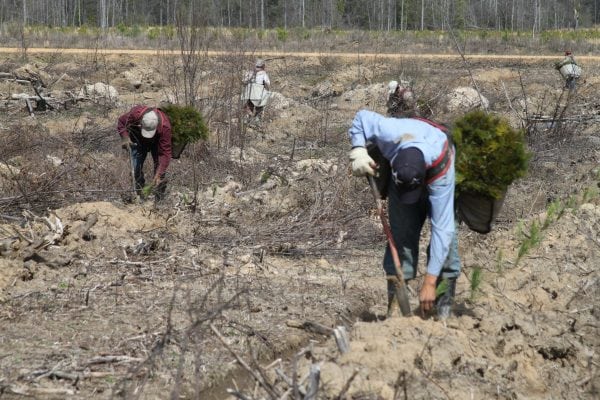
Good and acceptable forestry practices should be followed at all times. Seedlings should be kept in bags until planted.(Photo credit: T.R. Clark)
What does indemnification mean?
Indemnification means to hold harmless or protect from loss or damage. This section is important because it protects the landowner from being libel for the actions or result of actions by the contractor or his or her employees. This section may outline specific types of damage such as the following:
- Personal injury
- Property damage
- Improper use, handling, or disposal of hazardous materials
- Violation of laws
- Violation of best management practices
- Violation of immigration laws
What types of insurance are required?
Contractors should carry insurance for the duration of the contract. Landowners have the right to ask to see and obtain copies of proof-of-insurance forms before allowing work to begin and at any time during the process. Below are some basic facts about different types of insurance a contractor should carry.
- General liability. Protects the assets of a business when it is sued for something it did (or did not do) to cause injury or property damage. Typically, there is a $1,000,000 coverage requirement.
- Auto liability. Protects against damage caused by a vehicle. Typically, there is a $1,000,000 coverage requirement.
- Workers compensation. Provides wage replacement and/or medical benefits for employees who are injured in the course of employment in exchange for the right to sue the employer.
- Additional insured. Provides coverage for landowners and their agents. If the land-owner is sued due to accidents arising out of the work of the contractor, the contractor’s insurance will protect the landowner. Land-owners and their agents should specifically request to be named as additional insured under the contractor’s policy and should obtain a copy of additional insured documentation.
Rules
In the planting contract, this section provides information about who can have access to your property and how you expect it to be protected.
Is fire a concern?
Because there is the potential for fire with any operation, contractor responsibilities for fire prevention and protection are usually listed in a separate section in forestry contracts.
Is my property protected by this contract?
Any forestry-related activity has the potential for damage to property improvements, such as roads, fences, property markers, and drainage pipes. As such, a property damage section is often included in a planting contract. This section describes contractor responsibilities for repairing damaged items to their original state or compensating the owner for the damage.
How do I allow for access to my property?
Contractors and their employees need access to the property during the planting process to meet contract obligations. Terms of this access are usually outlined in the ingress or egress section of a contract. This section also protects the owner’s right to continue to access and use the property during all contracted activities.
Does the contractor have to let me know when work begins?
The contractor should always notify a landowner or the owner’s agent prior to starting a planting job. This will ensure that proper supervision can occur during all aspects of planting activity.
How is compliance with laws outlined?
State and federal law compliance is mandatory, and contractors should be familiar with and adhere to any and all state and federal laws related to their work. This includes employment laws. Contractors should not knowingly hire or recruit unauthorized immigrants and must be able to verify an employee’s or subcontractor’s immigration status.
Is the contractor my employee?
No, a contractor is not the employee of the landowner or landowner’s agent at any time. It is very important to note that the agreement is between the contractor and the landowner only. The landowner is not responsible for supervision or wage payment of contractor’s employees.
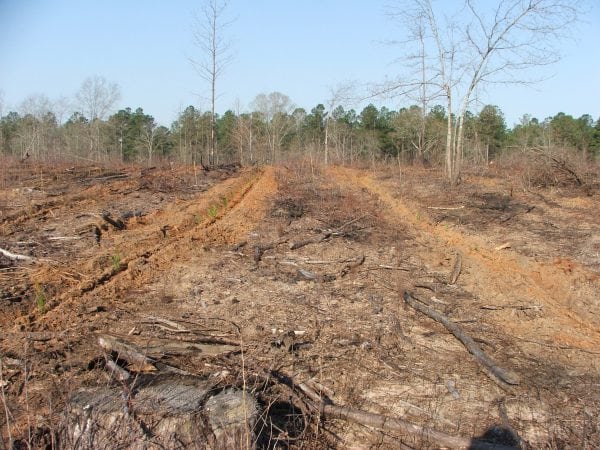
Machine planted forestland. (Photo credit: TR Clark)
Policy for Dispute Resolution
This section provides information on how potential legal problems could be handled.
What if there is a dispute between the contractor and me?
Unfortunately, disagreements do occur from time to time. If they cannot be resolved, the parties may go into arbitration—the process of settling a dispute without going to court. Rather than going before a judge or jury, arbitration uses a third-party panel comprised of registered foresters to help settle the dispute.
Signatures
All contacts are deemed official only if signed by all participating parties.
Will I have to sign any contract paperwork?
Yes, all contracts should be signed by both parties, and those signatures should be witnessed by a notary. If there is more than one owner, the signatures of all parties will be needed.
Exhibits
This very important section of the planting contract provides maps and descriptions of the area to be planted and specific seedling requirements.
What are contract exhibits?
Exhibits are located at the end of the contract and contain supplemental information on where planting will be conducted, how it will be conducted, and quality evaluations. The most common exhibits are discussed below.
Summary
Regenerating your forest is one of the most important long-term investments you can make as a forest landowner. For many landowners, planting is the most efficient regeneration method; however, improper planting can lead to poor survival and growth and, in some cases, the need to replant the following year. This is an expensive mistake that you do not want to make. A well-thought-out and executed contract can ensure that you and the planting contractor both understand what needs to be done and when, greatly improving chances for planting success.
For more information
Alabama Cooperative Extension System offices
Southern Forest Nursery Management Cooperative
Alabama Forestry Commission office in your area
Download a PDF of Tree Planting Contracts for Landowners: FAQs, ANR-1458.

